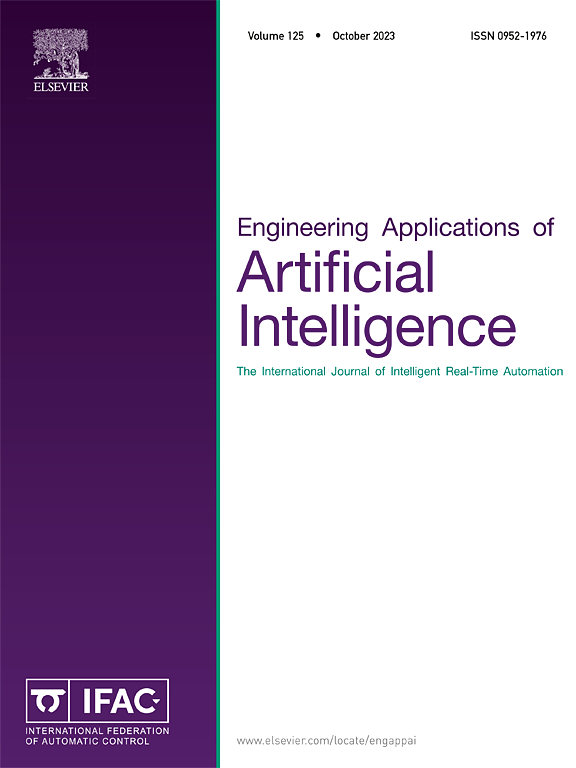A feature matching-based method for few-shot multivariate time series anomaly detection with symmetric patch mask Siam Transformer
IF 7.5
2区 计算机科学
Q1 AUTOMATION & CONTROL SYSTEMS
Engineering Applications of Artificial Intelligence
Pub Date : 2025-05-02
DOI:10.1016/j.engappai.2025.110894
引用次数: 0
Abstract
Accurate anomaly detection of industrial system operating status based on multivariate time series data is an important means to ensure the stable operation of the system. However if there is insufficient training data for the objects to be detected, it is difficult for existing deep learning methods to learn a clear outline of the normal pattern of the data under unsupervised conditions, leading to the failure of anomaly detection. This paper proposes a feature matching-based method for few-shot multivariate time series anomaly detection with a symmetric patch mask Siam Transformer (SPMST). Using only a small number of normal samples from the target domain, SPMST realizes the rapid deployment of the universal representation model pre-trained on multiple public datasets to the target domain without the need for retraining or parameter adjustment for more categories. First, two augmented views of the original data are obtained by adding a symmetric patch mask to the augmented aligned multisource data. The Transformer model is then pre-trained with reconstruction and contrastive learning tasks to acquire robust latent representations. Second, the feature support set of the target domain is obtained based on the pre-trained representation model and the proposed clustering-based support set reduction strategy, avoiding excessive consumption of computing resources. Finally, the anomaly score is calculated by combining the feature matching loss, reconstruction loss, and contrastive loss. The experimental results show that SPMST, under few-shot conditions, is not weaker than 21 state-of-the-art baselines trained with a large amount of data on 5 representative cyber–physical system datasets.
基于特征匹配的多变量时间序列对称斑掩模Siam Transformer异常检测方法
基于多变量时间序列数据对工业系统运行状态进行准确的异常检测是保证系统稳定运行的重要手段。然而,当待检测对象的训练数据不足时,现有的深度学习方法很难在无监督的情况下清晰地勾勒出数据的正常模式,导致异常检测失败。提出了一种基于特征匹配的对称贴片掩模Siam Transformer (SPMST)的小镜头多元时间序列异常检测方法。SPMST仅使用目标域的少量正态样本,实现了在多个公共数据集上预训练的通用表示模型快速部署到目标域,而无需对更多的类别进行再训练或参数调整。首先,通过在增强的对齐多源数据上添加对称的补丁掩码,获得原始数据的两个增强视图;然后使用重建和对比学习任务对Transformer模型进行预训练,以获得稳健的潜在表征。其次,基于预训练的表征模型和提出的基于聚类的支持集约简策略获得目标域的特征支持集,避免了过多的计算资源消耗;最后,结合特征匹配损失、重建损失和对比损失计算异常分数。实验结果表明,在少量射击条件下,SPMST不弱于5个代表性网络物理系统数据集上用大量数据训练的21条最先进基线。
本文章由计算机程序翻译,如有差异,请以英文原文为准。
求助全文
约1分钟内获得全文
求助全文
来源期刊

Engineering Applications of Artificial Intelligence
工程技术-工程:电子与电气
CiteScore
9.60
自引率
10.00%
发文量
505
审稿时长
68 days
期刊介绍:
Artificial Intelligence (AI) is pivotal in driving the fourth industrial revolution, witnessing remarkable advancements across various machine learning methodologies. AI techniques have become indispensable tools for practicing engineers, enabling them to tackle previously insurmountable challenges. Engineering Applications of Artificial Intelligence serves as a global platform for the swift dissemination of research elucidating the practical application of AI methods across all engineering disciplines. Submitted papers are expected to present novel aspects of AI utilized in real-world engineering applications, validated using publicly available datasets to ensure the replicability of research outcomes. Join us in exploring the transformative potential of AI in engineering.
 求助内容:
求助内容: 应助结果提醒方式:
应助结果提醒方式:


